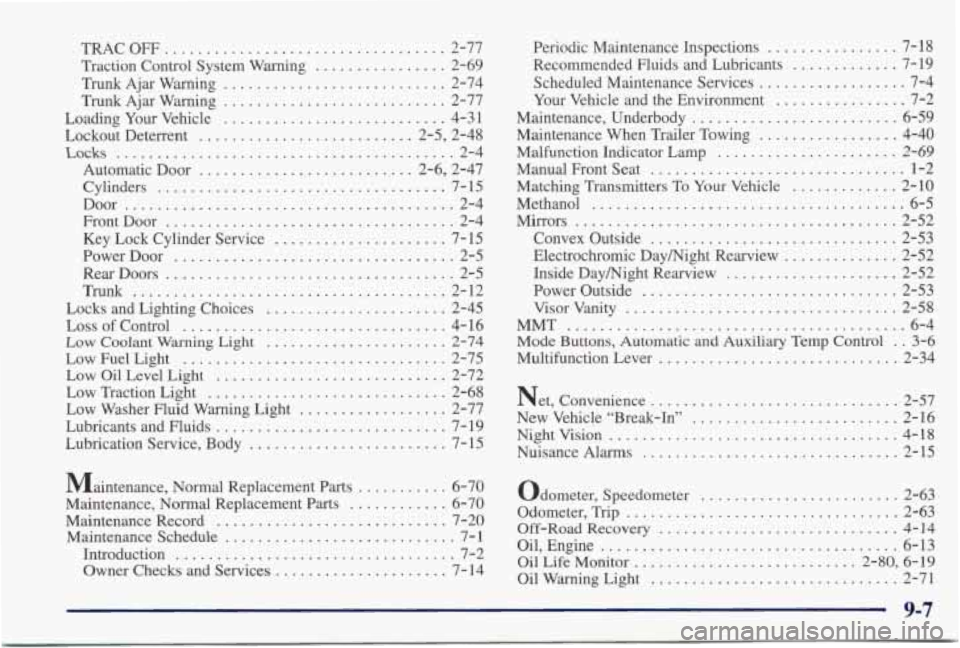1998 PONTIAC GRAND PRIX night vision
[x] Cancel search: night visionPage 210 of 402

If your vehicle starts to slide, ease your foot off the
accelerator pedal and quickly steer the way you want the
vehicle to go.
If you start steering quickly enough, your
vehicle may straighten out. Always be ready for a
second skid
if it occurs.
Of course, traction is reduced when water, snow, ice,
gravel or other material is on the road. For safety, you’ll
want to slow down and adjust your driving to these
conditions. It
is important to slow down on slippery
surfaces because stopping distance will be longer and
vehicle control more limited.
While driving
on a surface with reduced traction, try
your best to avoid sudden steering, acceleration or
braking (including engine braking by shifting to a
lower gear). Any sudden changes could cause the tires
to slide. You may not realize the surface is slippery until
your vehicle is skidding. Learn to recognize warning
clues
-- such as enough water, ice or packed snow on
the road to make a “mirrored surface” -- and slow down
when you have any doubt.
Remember: Any anti-lock brake system
(ABS) helps
avoid only the braking
skid.
Driving at Night
Night driving is more dangerous than day driving. One
reason is that some drivers
are likely to be impaired -- by
alcohol or drugs, with night vision problems, or by fatigue.
4-17
Page 211 of 402

Here are some tips on night driving.
Drive defensively.
0 Don’t drink and drive.
0 Adjust your inside rearview mirror to reduce the
glare from headlamps behind you.
0 Since you can’t see as well, you may need to
slow down and keep more space between you and
other vehicles.
0 Slow down, especially on higher speed roads. Your
headlamps can light up only so much road ahead.
0 In remote areas, watch for animals.
If you’re tired, pull off the road in a safe place
and rest.
Night Vision
No one can see as well at night as in the daytime. But as
we get older these differences increase. A 50-year-old
driver may require at least twice as much light to see the same thing at night as a 20-year-old.
What you do
in the daytime can also affect your night
vision. For example, if you spend the day in bright
sunshine you are wise to wear sunglasses. Your eyes will
have less trouble adjusting to night. But
if you’re
driving, don’t wear sunglasses at night. They may cut down
on glare
from headlamps, but they also make a lot
of things invisible.
You can be temporarily blinded by approaching
headlamps.
It can take a second or two, or even several
seconds, for your eyes to readjust to the dark. When
you
are faced with severe glare (as from a driver who
doesn’t lower the high beams, or a vehicle with
misaimed headlamps), slow down a little. Avoid staring
directly into the approaching headlamps.
Keep your windshield and all the glass on your vehicle
clean
-- inside and out. Glare at night is made much
worse
by dirt on the glass. Even the inside of the glass
can build up a film caused by dust. Dirty glass makes
lights dazzle and flash more than clean glass would,
making the pupils
of your eyes contract repeatedly.
Remember that
your headlamps light up far less of a
roadway when you are in a turn or curve. Keep your
eyes moving; that way, it’s easier to pick out dimly
lighted objects. Just as your headlamps should be
checked regularly for proper aim,
so should your eyes
be examined regularly. Some drivers suffer
from night
blindness
-- the inability to see in dim light -- and
aren’t even aware
of it.
4-18
Page 388 of 402

TRACO FF ................... ... 2-77
Trunk Ajar Warning
........................... 2-74
Trunk Ajar Warning
........................... 2-77
Loading Your Vehicle
........................... 4-3 1
Lockout Deterrent .......................... 2-5, 2-48
Automatic Door
.......................... 2-6, 2-47
Cylinders
................................... 7-15
Door
........................................ 2-4
FrontDoor
................................... 2-4
Key Lock Cylinder Service
..................... 7-15
PowerDoor
.................................. 2-5
RearDoors
................................... 2-5
Locks and Lighting Choices
...................... 2-45
Loss
of Control ................................ 4- 16
Low Coolant Warning Light ...................... 2-74
Low Fuel Light ................................ 2-75
Low Oil Level Light
............................ 2-72
Low Traction Light
............................. 2-68
Low Washer Fluid Warning Light
.................. 2-77
Lubricants and Fluids
............................ 7- 19
Lubrication Service, Body
........................ 7-15
Maintenance, Normal Replacement parts
........... 6-70
Maintenance, Normal Replacement
Parts ............ 6-70
Maintenance Record
............................ 7-20
Maintenance Schedule
............................ 7- 1
Introduction .................................. 7-2
Owner Checks and Services
..................... 7-14
Traction Control System Warning
.... ..... 2-69
Locks ......................................... 2-4
Trunk
...................................... 2-12 Periodic Maintenance Inspections
...... .... 7-18
Recommended Fluids and Lubricants ............. 7-19
Scheduled Maintenance Services
.................. 7-4
Your Vehicle and the Environment ................ 7-2
Maintenance. Underbody
......................... 6-59
Maintenance When Trailer Towing
................. 4-40
Malfunction Indicator Lamp
...................... 2-69
Manual Front Seat ............................... 1-2
Matching Transmitters
To Your Vehicle ............. 2-10
Methanol
...................................... 6-5
Mirrors
....................................... 2-52
Convex Outside
.............................. 2-53
Electrochromic Daymight Rearview
.............. 2-52
Inside Daymight Rearview
..................... 2-52
Power Outside
............................... 2-53
Visor Vanity
................................. 2-58
MMT
......................................... 6-4
Mode
Buttons. Automatic and Auxiliary Temp Control . . 3-6
Multifunction Lever
............................. 2-34
Net. Convenience
.............................. 2-57
New Vehicle “Break-In”
......................... 2-16
Nightvision
................................... 4-18
Nuisance Alarms
............................... 2-15
Odometer. Speedometer
...... ......... 2-63
Odometer. Trip
................................. 2-63
Off-Road Recovery
............................. 4-14
Oil, Engine .................................... 6-13
Oil Life Monitor
........................... 2-80. 6-19
Oil Warning Light .............................. 2-71
9-7